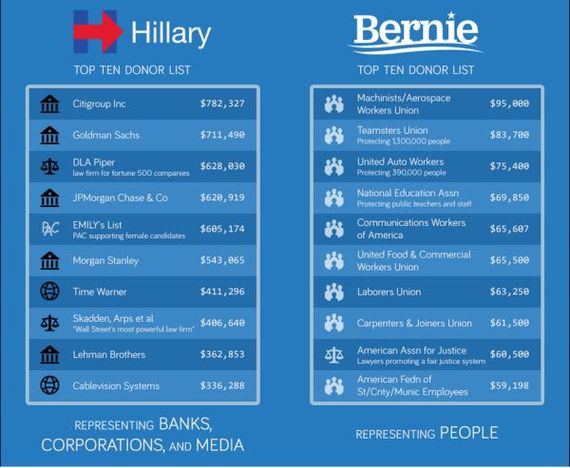The National Education Association (the union to which I used to belong) is
considering an early endorsement of Hillary Clinton. This decision, like the American Federation of Teachers' endorsement of Clinton on July 11, would be a huge mistake.
One reason is that it would violate members' trust. As
Peter Greene,
Steven Singer, and
Anthony Cody have noted, teacher voice is too often ignored in education reform conversations. If the NEA follows the AFT and makes a presidential primary endorsement without ample membership involvement, its teachers will feel silenced by their own union. Not only would that likely depress voter mobilization efforts and
spark a backlash within the union, it also runs counter to the very principles of what a union is supposed to be.
An early Clinton endorsement would also be a mistake because she's a suboptimal candidate. While Clinton is far more union-friendly than anyone running for the Republican nomination, her labor credentials are significantly worse than her main challenger in the Democratic primary, Vermont Senator Bernie Sanders.
Sanders has been a
steadfast union supporter since the 1970s. His advocacy on behalf of workers as mayor of Burlington, Vermont in the 1980s helped foster the growth of the city's socially-responsible business culture.
"Thanks to the enduring influence of the progressive climate that Sanders and his allies helped to create in Burlington,"
The Nation reported in June, "the city's largest housing development is now resident-owned, its largest supermarket is a consumer-owned cooperative, one of its largest private employers is worker-owned, and most of its people-oriented waterfront is publicly owned. Its publicly owned utility, the Burlington Electric Department, recently announced that Burlington is the first American city of any decent size to run entirely on renewable electricity."
Sanders has continued to advocate for the same causes in Congress over the past 25 years. In 1994, for example, he introduced the
Workplace Democracy Act, legislation designed to strengthen collective bargaining rights. He currently supports the
Employee Free Choice Act, which would make it easier for workplaces to hold union elections, and
plans to introduce a new Workplace Democracy Act this fall. He has "
convened annual meetings of labor activists to help them develop more successful organizing and bargaining strategies" and still
walks picket lines with workers.
To be fair, Clinton also supports the Employee Free Choice Act. Her
campaign rhetoric is pretty pro-union, and the promises she makes in her
video to NEA members don't sound all that different than those made by Bernie.
But Clinton's record is significantly worse than Sanders's. She served on the board of directors of Walmart -- which
to this day remains one of the nation's most
notoriously anti-union businesses -- from 1986 to 1992, for instance.
According to
reports that surfaced in 2008, Clinton sat through dozens of board meetings without ever speaking up on behalf of organized labor. Instead, she stated that she was "proud of Wal-Mart and what we do and the way we do it better than anybody else." Though she has since renounced Walmart's business practices, Clinton
maintains close ties with Walmart executives and lobbyists. And during her presidential campaigns, she's
surrounded herself with
staffers who have troubling anti-union connections.
The following meme, describing cumulative donations the candidates have received over the past thirty years, is illustrative:
![2015-09-28-1443412698-9527926-CampaignContributors.jpg]()
Clinton has worse policy positions on key union issues as well. Bernie Sanders has been
a leader in the effort to oppose the Trans-Pacific Partnership, a "free trade" deal that
could undermine environmental and consumer safety protections and have harmful impacts on workers both in the U.S. and abroad.
Clinton, despite recent attempts to distance herself from the TPP, was
heavily involved in negotiating and promoting it. Sanders has been a
vocal proponent of a $15-an-hour federal minimum wage by 2020, which workers around the country are
campaigning for; Clinton
long resisted taking a specific position on the issue and only recently
spoke favorably about raising the federal minimum to $12-an-hour.
Sanders's positions on education issues also tend to be more
power-balancing than Clinton's. Both candidates have called for universal pre-K and increased college affordability, but while Sanders believes education is a right that should be
guaranteed free of charge to all students, Clinton
hypocritically opposes free college for "kids who don't work some hours to try to put their own effort into their education." At the K-12 level, Sanders also has a stronger vision and record.
After initially supporting the House of Representatives' version of No Child Left Behind in May of 2001, he voted against the final version of NCLB that year
because he foresaw problems with "the bill's reliance on high-stakes standardized testing to direct draconian interventions;" Clinton, on the other hand, cast her vote in favor of NCLB.
Sanders believes that "the federal government has a critical role to play" in education policy, one that includes "guaranteeing resource equity," "increased emphasis on a well-rounded curriculum," and providing "the resources necessary to provide effective professional development."
Clinton might not necessarily disagree, but while Sanders
asserts that he will "direct education funding toward the low-income students who need it most" in his response to the AFT's candidate questionnaire, this commitment is noticeably absent from Clinton's
writeup.
In fact, on practically every topic -- from
criminal justice issues to
health care to
foreign policy -- Sanders has Clinton beat. His platform isn't perfect, but it's far and away more in line than Clinton's with what typical Democratic voters profess to want.
As far as I can tell, nobody at the AFT (or NEA) actually argues that Clinton has better policy positions than Sanders; their endorsement processes seem to be driven by the belief that Clinton is more electable.
The problem with that thinking is twofold.
First, Sanders is actually just as electable, if not more so, than Clinton. In
national polls that pit potential Democratic nominees against potential Republican nominees, Sanders and Clinton do about as well as each other.
If Sanders had anything like Clinton's name recognition, he'd almost certainly outstrip her. Among voters who know who he is, Sanders's favorability is much higher than Clinton's (see
page 5). He's shooting up in Democratic primary polls as more and more voters learn about him and now holds
sizable leads in New Hampshire, Iowa and
Oregon.
College students
prefer Sanders to Clinton by more than a 3-to-1 margin, policy positions like the ones he holds are
wildly popular across the board, he's shown the ability to earn the
support of voters that Democrats typically write off, and his campaign is showing no signs of losing momentum.
Second, the biggest impediment to a Sanders victory is none other than the political calculus the unions seem to be engaged in. Politicians are electable if people are willing to support them, while concerns about electability generally
undermine progressive goals and become self-fulfilling prophecies. Rather than settling for Hillary Clinton because they -- erroneously -- think she's the best that people will buy, unions should rally behind the better candidate -- Bernie Sanders -- and start selling him to the American public.
Labor for Bernie, a grassroots movement started by rank-and-file union members, could ultimately prove more important than endorsements from the major national unions. And Sanders already has the support of
National Nurses United.
Nonetheless, it's incumbent upon NEA leadership, and the leaders of other major unions, to start paying attention to why so many
union members feel the Bern. Sanders, much more than Clinton, deserves organized labor's official support.
A version of this post first appeared on 34justice.
-- This feed and its contents are the property of The Huffington Post, and use is subject to our terms. It may be used for personal consumption, but may not be distributed on a website.
![]()
![]()
![]()
![]()
![]()
![]()
![]()
![]()


































